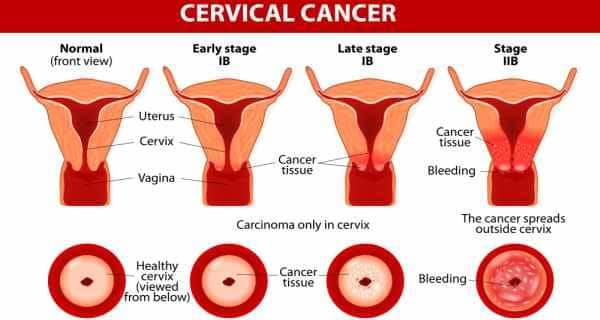Cervical cancer
Cervical cancer is the commonest cancer in Indian women and a quarter of the world’s cervical cancer patients live in India!Caused by infection with the Human Papilloma Virus( HPV), cervical cancer involves the opening of the uterus into the vagina. It occurs more commonly in women who start sexual activity at a young age and is also more common in women with many childbirths and partners.
Risk Factors
Here are some of the risk factors about which every woman should be aware of.
Here is detailed information related to 11 risk factors for cervical cancer.
Symptoms
 In early stages (even in the precancerous stages), cervical cancers usually do not cause symptoms. Only during the later stages of cancer is when one or more of these symptoms may be noticeable:
In early stages (even in the precancerous stages), cervical cancers usually do not cause symptoms. Only during the later stages of cancer is when one or more of these symptoms may be noticeable:
However, the above symptoms can also be caused by infections or other health problems. Hence, it is very important to consult your gynaecologist.
Diagnosis
The process of transformation of a precancerous state to cervical cancer takes approximately 10 years or more. During this period, a simple test called Pap smear can detect this precancerous state.
Pap smears are recommended for all sexually active women, the test being repeated at three yearly intervals if normal and at 5 yearly intervals if both Pap smear and testing for high risk strains of HPV are negative.
VIA, a simple test, which basically consists of applying vinegar to the cervix and then inspecting it, can be easily administered by health workers. In a landmark study by Tata Memorial Centre, Mumbai, mass screening of women was found to reduce the risk of dying due to cervical cancer by a whopping 30 %. It is known that mass screening for cervical cancer once in 10 years can reduce the incidence of this disease by 60 %!
Treatment
The affected area of the cervix can be effectively treated by a gynecologist using simple treatment methods. Here are some of the treatment options for cervical cancer:
Precancerous changes in the cervix may be treated with cryosurgery and laser surgery.
The treatment options for women with cervical cancer are surgery, radiation therapy, chemotherapy or a combination of two or more of these methods.
Here is a detailed information on the various treatment options for cervical cancer.
Prognosis
When followed up and treated properly, pre-cancerous conditions of cervical cancer are completely curable. There is 92% chance of a five-year survival for cancer that has spread to the inside of the cervix walls but not outside the cervix area. The five-year survival rate falls steadily as the cancer spreads into other areas.
Prevention
Here are are a few things you can do to prevent cervical cancer:






0 Comments